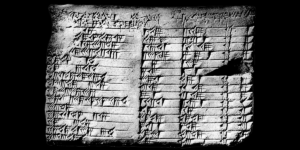
The Grammar of English Literature
In this essay, the author examines the dynamic interplay of syntax and semantics in English literary grammar. Through detailed comparisons of original and edited excerpts, it highlights challenges in achieving cohesion and coherence, showcasing the impact of syntactic transformations on information structure. From topicalization to inversion, the essay previews diverse syntactic tools in literature, emphasizing the creative and transformative nature of literary grammar.
Writing a story [...] the author only has words to depend on to create to any extent any number of effects he wishes for the reader to experience.
Information structure, at a glance
Writing a story, whether it tends toward prose or poetry, the author only has words to depend on to create to any extent any number of effects he wishes for the reader to experience. However, a novel, for instance, is a world of difference from, say, a movie, in that multiple layers of information (visual, audio, textual, etc) in the latter case are available at once in any given scene, whereas in the former it is only text—and text only—that lines the writer’s armament.
Therefore, stylistic considerations aside, cohesion and coherence alone are hard enough to achieve in descriptive and narrative writing, not least when it is long, intricate, nuanced, abstract, imaginative, and highly original.
In light of these qualities, information structure especially matters in literary writing; in essence, it pertains to how information is arranged within a sentence.
Consider Passage A:
1 “Be the Ōsanshōuo, the Giant Salamander.” 2 Kenji wished he’d long heeded the late sensei’s advice, that he should’ve known better than to be a loyally dull sword. 3 After an eternity, he was finally warming up to his aphorism, which he now realized was only decipherable in such a moment. 4 But he had first to rid himself off this cursed land, which would soon be drowned in turmoil and bloodshed, a new kind of struggle with which he wanted nothing to do, to savor the aftertaste of his ill-gotten rebirth. 5 He pulled his katana out through the Daimyo’s flaccid chest in a ghostly limber, a retrospective gesture much like the smell of rust in the air, and was relieved that the rōnin that had just awoken deep within him felt neither guilt nor shame.
The avid reader will note that at certain points in the passage the transition between two consecutive sentences seem awkward, to say the least, most notably from (3) to (4). By the end of sentence (3), the phrase “in such a moment” creates expectation in the reader; naturally, what follows—suppose that the writer wishes to build up to the key revelation that Kenji had slain the Daimyo—should have been the phrase “his ill-gotten rebirth” at the end of sentence (4), instead of “but he had first to rid himself…” the distance between which and the infinitival clause “to savor the aftertaste,” at the same time, is simply too long.
On the other hand, there is also the issue of ambiguity, best demonstrated in sentence (5), where it is not immediately clear whether the phrase “a retrospective gesture” is an appositive to the antecedent, “a ghostly limber,” or the way Kenji pulled out the sword as described in the matrix clause.
Syntactically, i.e. with regard to sentence structure, virtually every sentence in this passage employs a rather standard, if not menial, subject-verb-object constituent order, resulting in a rather plain reading experience.
In addition to information structure, some of the subclauses certainly feel unnecessarily “heavy” and can easily be reduced with the help of participles. In light of this, consider the following edit:
1 “Be the Ōsanshōuo, the Giant Salamander.” 2 The late sensei’s advice, Kenji wished he’d long heeded, that he should’ve known better than to be a loyally dull sword. 3 After an eternity was he finally warming up to his aphorism, decipherable, he now realized, only in moments such as this. 4 But to savor the aftertaste of his ill-gotten rebirth he had first to rid himself off this cursed land, soon to be drowned in turmoil and bloodshed, a new kind of struggle he wanted nothing to do with. 5 In a ghostly limber he pulled his katana out through the Daimyo’s flaccid chest, a gesture as retrospective as the smell of rust in the air, relieved that the rōnin having awoken deep within him felt neither guilt nor shame.
Transformation, at a glance
On the other hand, here we find another example, Passage B:
1 If only I could freeze that mighty instant on that completely dwarfed hill, when alongside all that joy and sorrow and whatnot it is by mere fate that our entire existence be cosmically wheeled into the solar pit, over and over, and when out poured its first hint of light, of fire, of life, at once the reddest and maddest glare, steeply tapered and pointed like a ravenous saber’s snare, yet, which rules heaven and hell, forest and swamp, dollar and dime, in that absolutely inexorable flare, with no mercy, nor urgency, nor sagacity, decidedly and repeatedly it but devours all that has been, and will have been, living and dying—not until then did it strike me, with such clarity and in such permanence, that among the uncountable, untouchable, unseeable, far away from the unreachable and wide across the untraversable, that it has always been—and will always be—both violent and benevolent, this star of ours.
This passage has no narrative elements and hence may be regarded as being “purely descriptive”. Surely it does sound a little crazy, stuffing into a single sentence as many as 155 words, but here the reader is reminded that in the literary genre this isn’t all that uncommon. That said, the many poetic devices employed in this passage demonstrates that the writer has within his toolkit the freedom, both syntactic and lexical, to move along the prose-poetry spectrum. One relevant detail to note here is that of parallelism, or parallel structure, which is to be seen more broadly as a morphosyntactic-semantic, if not also pragmatic, category in linguistics, seeing that it can be achieved by both grammatical and lexical means, though given our focus here we are only interested in the former. For instance, the two relative clauses, “when alongside…“ and “when out poured…“, in addition to leading with the same relative adverb “when“, are markedly parallel in that on a clausal level they both have fronted elements or, rather, postponed subjects.
In our English Masterclass, we are primarily concerned with syntactic transformation, our goal being to enable you to distribute textual information, both on the intra- as well as intersentential (or contextual) levels, and on the clausal as well as to some degree phrasal levels, in such a manner that it is from the reader’s perspective not only coherent (as in unambiguous) and cohesive (as in it “flows”) but also ultimately effective (as regards e.g. emotion, imagery, sound). For now, we return to the two passages above for a preview of the array of syntactic transformations you will learn from us.
In Passage A (edited), the object (O) in sentence (2): “The late sensei’s advice“, is fronted before the subject (S) and the verb—or predicator (P), and together with the punctuation (comma) this particular syntax, O-S-P, is preferred to the ordinary S-P-O in the unedited version for, among others, two chief reasons: One, the fronted object connects directly with the preceding sentence (1), i.e. the “advice“ itself, thus improving cohesion, and accordingly also coherence, on the reader’s end. Two, it helps to end the matrix clause with the verb “heeded“ as it adds a flavor of actionality to the following appositive clause, “that he should have known better…“ Ordinarily, if such an appositive were not intended by the writer, it would be tough to justify such a transformation, for fronting the object leaves the verb dangling at the end, which in accord to the principle of end-weight is usually advised against, though it should be noted here that such fronting is characteristic of unplanned speech, so for instance, end-weight may be “overruled” in certain cases of direct speech.
In sentences (3), (4) and (5), the adverbials (A), “after an eternity“, “but to savor the aftertaste…” and “in a ghostly limber“, are fronted instead. In fact, among the sentence functions, the adverbial is the most mobile constituent in a sentence, particularly in the case of a nonrestrictive adverbial, or adjunct, fronting which merely fills one of various adverbial positions within a sentence, a clause, or even a phrase. In all these cases adverbial fronting is justified on the grounds of information structure and cohesion, as has already been discussed above.
At the same time, though, we note that in each of these same sentences there are also heavy elements toward the end; these appositives and nonfinite clauses (participial and infinitival), which are fairly typical of English literature, essentially get focalized while end-weight is maintained. In contrast, when a sentence constituent is fronted, it is said to be topicalized. Here, a distinction is made between what appears at the beginning of a sentence and that at the end, respectively the topic and the focus, or theme and rheme, of a sentence—a vital concept we will keep revisiting. Put bluntly, it is generally agreed that in reading a sentence the reader is first introduced to the topic and then gradually led toward the end of the sentence where information is better remembered. Aside from the limit of human memory, stopping a sentence has a way of funneling the reader’s attention on whatever constituent that comes right before the period.
In a nutshell, topicalization and focalization work hand in hand in the design of a sentence, i.e. a conscious decision to be made throughout the writing process. Therefore, besides end-weight, which is principally syntactical, the writer is also guided, semantically, by the principle of end-focus. However, note that end-weight and end-focus frequently come into conflict with each other, and it is often a burden the writer has no choice but to shoulder in search for an optimal balance in the name of an immersive reading experience. Plus, it certainly does not help that decision making upon these principles is also accompanied with considerations that are highly contextual, to which we will return shortly.
However, note that end-weight and end-focus frequently come into conflict with each other, and it is often a burden the writer has no choice but to shoulder.
Now, let’s turn our attention to a number of syntactic transformations in Passage B, chief among which is inversion, between the subject and the verb. This is most pronounced in the relative clause “when out poured its first hint of light“, where the entire predicator, “poured“, is fronted before the subject, “its first hint of light“, in this case triggered by the fronted adverbial, “out“, resulting in a more dramatic effect as the action precedes the subject.
Inversion is similarly observed in the nonessential clause toward the end: “not until then did it strike me…“ in which case only the auxiliary verb “did“ is fronted (this form of inversion we call partial inversion), triggered by the pre-fronted negative adverbial “not until then“.
Semantically, we will learn that inversion triggered in such cases essentially shifts the scope of negation from local to global (c.f. “It did not strike me until then that…“ and “Not until then did it strike me that…”), in the latter the effect of negation encompassing the entire clause. Though not triggered by negation, partial inversion is also seen in sentence (3) in Passage A (c.f. “After an eternity he was finally…“ and “After an eternity was he finally…“)
Moving on, note the ending of Passage B: “it has always been both violent and benevolent, this star of ours.” This clause contains two subjects, the provisional “it“, which is semantically empty, i.e. a mere syntactic placeholder, and the real subject “this star of ours“. In standard syntax, one would write: “this star of ours has always been both violent and benevolent“. Postponing the subject in this case and replacing it with a “dummy” subject—a transformation known specifically as extraposition—in effect focalizes the real subject, while the optional comma in essence gives it a so-called double focus.
Last but not least, one particularly intriguing transformation that needs to be highlighted here is also found in Passage B, where the relative clause “which rules heaven and hell…“ is oddly the antecedent to its superordinate subject “it“, instead of being the postcedent as in relativization proper, i.e. the formation of relative clause. For a simpler view, compare the following sentences:
A The city, whose inmates labor through the day in exchange for that which they flaunt through the night, never sleeps, and in the rare instances when it does, it snores like a fat, irritable warden, his giant whip always ready by the hip.
B Whose inmates labor through the day in exchange for that which they flaunt through the night, the city never sleeps, and in the rare instances when it does, it snores like a fat, irritable warden, his giant whip always ready by the hip.
While in both cases this transformation is clearly warranted on both bases of end-weight and end-focus, mostly because of the second independent clause, it also helps to optimize information structure in the first independent clause, noting that in its first version the rather long relative clause occupies the position between its subject “the city” and predicate “never sleeps“, thus straining the relationship between them by means of displacement, which risks incoherence as a result. In its second version there is also the potential advantage of topicalizing “inmates“, the figure of speech for the people living and working in the city, rather than the city itself, which as it seems is used in this sentence only literally and should therefore warrant less semantic—thus syntactic—priority.
Taken as a whole, after the edit we now have a sentence that opens with a thematic illustration of the city dwellers as “inmates“ (as though they were imprisoned), leading to an end-focus on the subject, “the city“ (implicitly metaphorized as “mud“), being described as a “warden” (supposedly who heads the authority over the “prison”) carrying a “giant whip” (presumably to punish the “inmates” for not laboring hard or loyally enough). The theme jives with the rheme in that their relationship is amplified, such that it not only becomes easier but perhaps also more rewarding for the reader to connect the dots.
Above all, what we have seen here in these examples of informational-structural transformation is a tight-knit linguistic relationship between syntax and semantics—between the forms of structure and the forms of meaning. More specifically, it is worth noting here that it is always the latter that justifies the former, and consequently it is always the former that effects the latter.
Ultimately, the literary genre is where information structure gets to be much more creative and “malleable” than it does in the case of, say, an exposition. Ergo, we may say that in practice the grammar of literature is highly transformative; it thus belies the storyteller to not utilize this feature in the course of crafting the reader’s journey.
The grammar of literature is highly transformative; it thus belies the storyteller to not utilize this feature in the course of crafting the reader's journey.
Let's talk!
TRIAL LESSON ONLY AT 49 MYR
Read our latest.
Access learning resources.
COMING SOON




